Day 1
So here I was, starting another climb with a test of my determination right from the very start. By 11 a.m., the two vans and a gear truck approached the trailhead parking lot. A mule team was waiting to load our gear. I could sense everyone, including myself, was feeling a little anxious, except for Doug, an art dealer from Oregon who had made it to Camp 3 just two weeks earlier but had to turn back because a guide became ill. We gathered our lighter packs with essentials for the three-hour hike to Camp Confluencia at 3,390m (11,122 ft). For me, my light pack was my 35 Osprey with day hiking essentials. I had poles that I rented that morning and immediately one broke, so I taped it together. In fact, the majority of everything I rented failed, from zippers to the fitted size of clothing. Fortunately, I had enough of my own gear for this leg of the trip. The clothes and shoes I had been wearing since leaving Boston were good enough. The weather was perfect, sunny with a 10-knot breeze—T-shirt weather. The hike in was great, I was able to get some conversations going with guides and clients and photographed some beautiful scenery. Up and down a dusty, sun-soaked trail, into the park we went. As planned, right on schedule, we made it to Camp Confluencia around 3 p.m. We set up our tents after retrieving our duffles from the mules. Many climbers go all the way to base camp in one shot but with the drive from Mendoza and logistics, this stop makes for an easy first day with some acclimating.
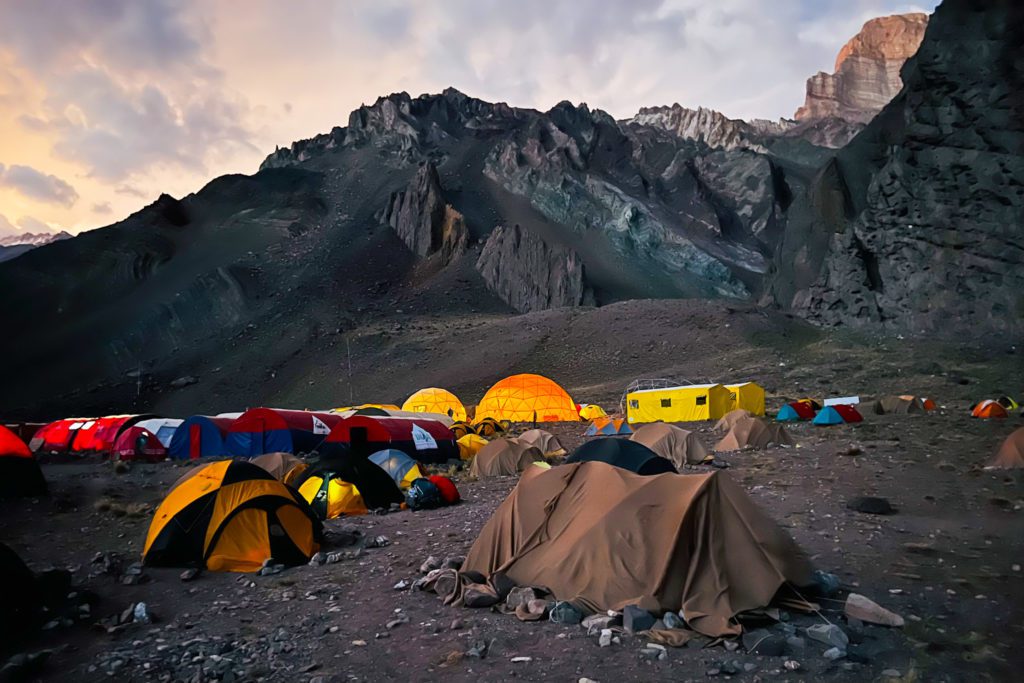
Canadian climber, James, was my tent mate. After James and I had our tent set and gear in order, we met our team along with a Russian team for dinner. The tents/domes are a large setup for a season of climbers coming and going. As our meal was finishing up and the sun was setting behind the Andes Mountain range, we heard the sound of a helicopter hovering, catching everyone’s attention. We could see through the windows in the tent. The helicopter was lowering a rope with some duffle bags attached. I could see a dark green one that looked like mine … and it was.
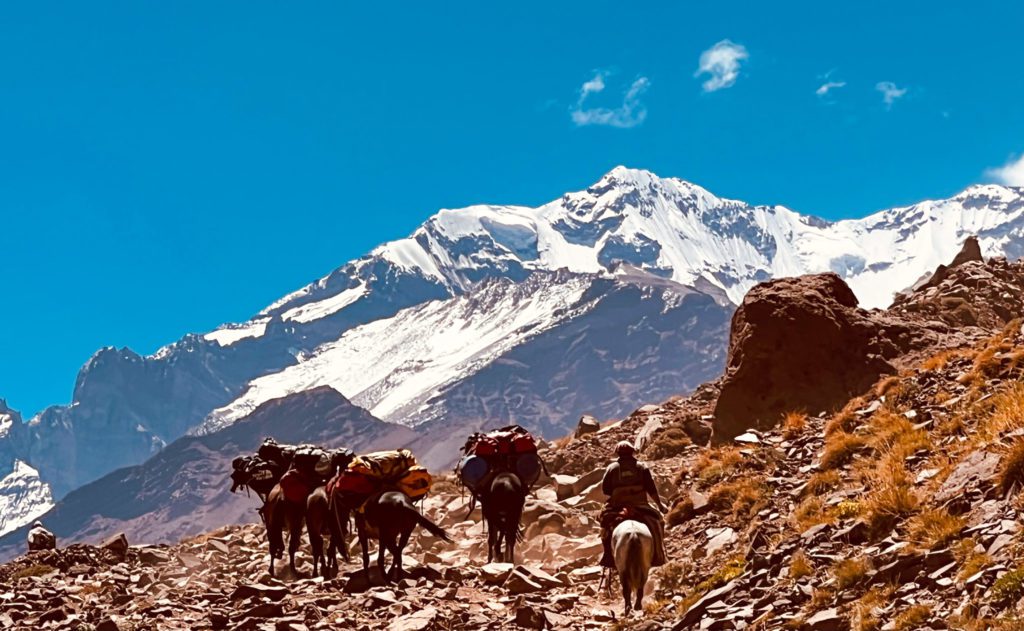

I thanked everyone who worked to get the bag for me. I could still text the airport helpers and Heather. I was elated. I grabbed my bag and headed to our tent to sort gear. It was a beautiful night, with stars so bright you were tempted to reach up and grab one. Not long after the full darkness set in, the temperature dropped. I climbed into the -25 sleeping bag with greater confidence, the first night of many on my journey to climb Mt Aconcagua.
Day 2
James and I had our tent and gear packed in minutes. Just as the sun was rising, we headed to breakfast for hot coffee and shortly after to the outhouse to get rid of unneeded weight. I filled my water bottle every chance I could, brushed my teeth and soon we were on the trail for a long day to base camp. The all-day hike was a gradual altitude gain, hiking over a couple of small valley streams, which turn into rivers in the rainy winter months.
Mule teams passed close to us at least twice an hour, raising the dust from the summer drought, a face mask of some kind was mandatory to keep from breathing the dust that would rise from the dry season the area had been experiencing. Our seven-hour hike to base camp went well. As we approached camp, I was beginning to feel the altitude. It was suggested I take a diamox about an hour before we settled into camp. It did help clear my head. I was feeling good enough to take photos of the team arriving at camp as a snow squall passed through.
Not long after we arrived the sun was setting behind the mountains that surrounded us and a cold evening was upon us as we set up our tents. We settled our gear into our tents with warmer layering than the night before. We were at Plaza de Mulas, 4,370m (14,337 ft), the Mountain’s base camp.
The camp was very busy, my guess would be about 150 people between climbers and workers. It was a little town, hustle and bustle late into the night. We had our own galley tent with cooks and servers, mostly all young college-age kids working their summer jobs. We shared our meal/meeting tent with a British team that was jubilant after summiting the day before. The setup was quite nice: We had a propane heater, solar phone charging station and intermittent internet service.
It was in this setting you could listen to many conversations and learn about an individual’s background. I was staying very quiet; I was feeling beat. The stress of getting settled and acclimatizing was taking hold. I was not in the best state of mind to be talking, so I was listening. While eavesdropping on the British team celebrating their summit, I learned a lot about what was ahead. The dinner tables were close together, so it was not hard to listen in. They were talking about the 10-hour summit push from Camp 3. Ten hours sounded good to me, that would be about a 14-to-16-hour day to reach the summit and get back to Camp 3. My group was speaking mostly in Spanish, so it was hard to understand what was being discussed.
After a gear check, I headed to dinner. I was not feeling great, the altitude was now affecting me more than it had earlier, but I was hungry so I ate well and drank plenty of water. It was becoming clear to me that the time at home in the hypoxic tent was not helping. I learned from listening to others who used the tent acclimating system that I did not spend enough time in the tent for it to have a positive effect. What I learned was that you have to be in the hypoxic tent for a minimum of 12 hours each night for an entire month to get any support for the real deal. Learning this was disappointing. I had spent six to eight hours a night in the tent for a month, hoping it would be helpful. Day two came to an end under another spectacular starry night of southern stars and constellations that I had not seen since a sailing trip to the Galapagos. It was cold now, below zero. As the night wore on, the -25 bag with a liner and a couple of layers, head to toe, made for a comfortable night’s sleep.
Base Camp, Day 3
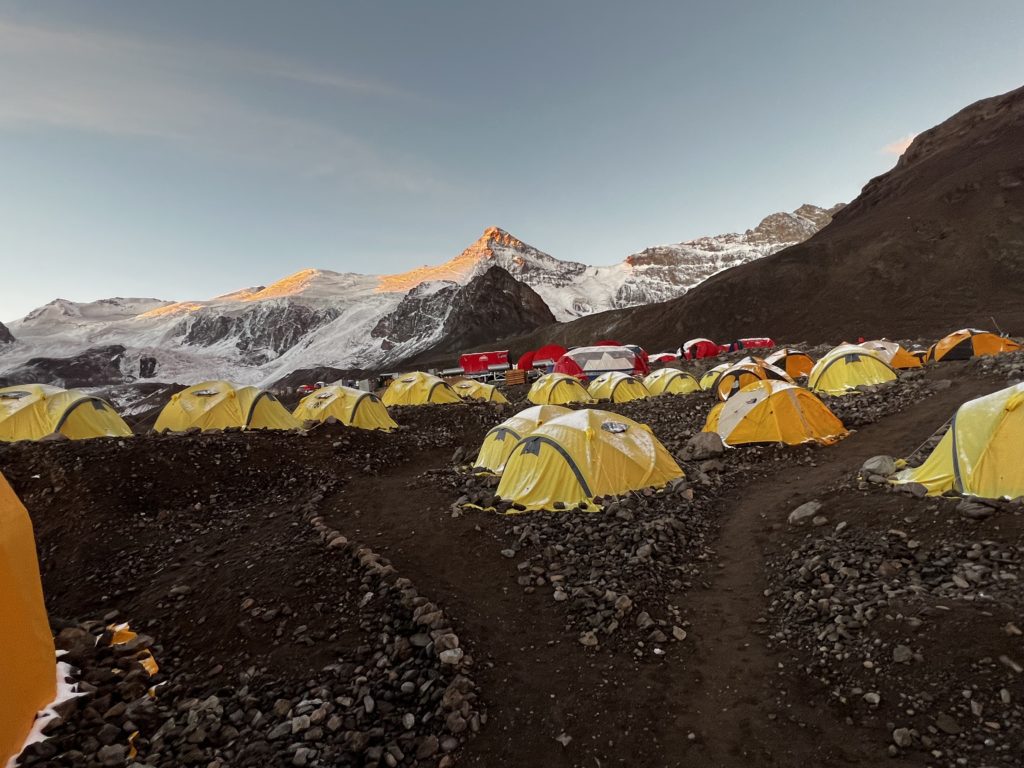
The morning’s sun-soaked rays worked their way through the mountain range and woke me around 6 a.m. I felt rested, but it was cold. Frost lined the tent from condensation, which had built up from our breathing. I bumped James. “Good morning,” I said. I did not get much of a response. Another “Good morning,” this time louder. Finally a grunting noise. I dressed in my sleeping bag, climbed over James, unzipped the flap and crawled out into the waking base camp. A line was forming at the outhouse 30 yards away. After a night of drinking water every hour and peeing every two, the trip to the outhouse could wait.
Since James did not move much or respond positively to my attempt to make conversation, I headed right to our team tent and found Michael at the breakfast table. I told him James seemed out of sorts and should be looked at. He understood and sent two guides to our tent. I settled in with the team at the breakfast table; this was a rest day, a relaxing acclimatizing day with nothing on the schedule. I was feeling groggy and sluggish, so the thought of not hiking was a relief. As our morning meeting ended, the sun had broken free from the surrounding peaks and was warming the camp.
During breakfast, we discovered James had pulmonary edema in his lungs and was rushed to the helicopter and then to a van to get him to the hospital. It all happened in minutes. When I went back to our tent, all his gear was gone except for a few items that I packed up in the hopes I would see him back in Mendoza.
I spent the day resting alone in the tent and walking around the camp. I was not 100% by a long shot, I was not feeling the energy it takes to do this. Not helping these feelings, I learned later that day that if James had not been moved down as fast as they did, he could have died. It is easy to tear yourself down with negative thoughts when you are alone with no one to work it out with; the days ahead were going to take me places I had never experienced before. To overcome the obstacles, I had to force myself to be positive in my mind and body.
After lunch, we had a mandatory check-in with the base camp doctors for blood oxygen level, heart rate and a verbal exchange for clarity. I had a blood oxygen of 89, I was good to go. Everyone on the team was good to go. The rest of the day was some short hikes around camp, some reading, packing gear, gear checks, and loading my gear bag for the porters. We had an early dinner as the sun set and then returned to our tents as the cold set in. I was in my bag alone in the tent all night long, drinking water and peeing every two hours. Having the tent to myself was great for the extra room, but it would have been a lot more comforting to have James’ company.
Day 4
The sunrise was beautiful, the tent was full of frost again as the morning rays lit it up. I was up and quickly moving my gear to the breakfast tent. I gave the porters a bag of non-essentials, which meant rather than carry a 50 lb pack, I had a 30 lb pack. The porters are optional, but the entire team used their service to move gear for us from Base Camp to Camp 2, 3 and High Camp. We were not in a big hurry to get going, it was about a four-hour hike to Camp 2 and we had all day to reach the camp, stash gear and food, and then head back to Base Camp. This was another day of acclimating to test how we were feeling. The hike to Camp 2 went well. We moved as a group pretty quickly. There were no issues for anyone to Camp 2 and back to Base.
Day 5
We hiked back to Camp 2, called Canada 5,050m (16,568ft), located all the gear we brought up the day before and started setting up our tents. My new tent mate was named Paul, a young father from Germany. He spoke English well and we got along great. We were both in similar spots, neither of us had a lot in common with the others, and we did not speak Spanish. It was great to have someone to talk to and share stories. Michael and Fernando cooked dinner as the day came to an end. The cold kicked in, and we were soon in our tents with our dinner. The weather was looking very favorable for a summit attempt in just two days.
Day 6
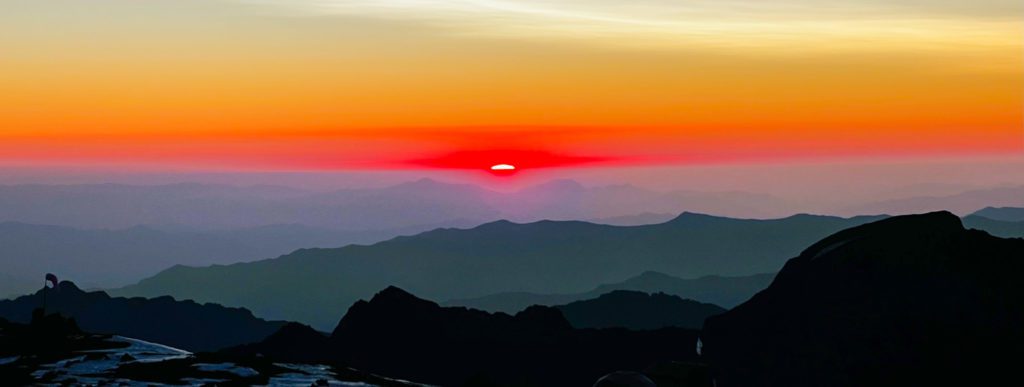
Woke to a sunrise that we could not see rising on the other side of Aconcagua, so it took some time to warm up the camp. A nice day, colder for sure with a breeze, but still ideal conditions overall. This was a rest day, hanging out in the tent and acclimating. I was taking half a Diamox pill twice a day. I was feeling the altitude but I did not have a headache, which was a plus, I just felt tired and sluggish. Mid-afternoon I took about a half-mile walk around the camp, taking photos of the views of Chile and the Pacific Ocean to the west and the Patagonia Mountain range and Cape Horn to the south. While on this walk, I heard a helicopter approaching. I saw a long rope and basket hanging from the helicopter, similar to watching my gear bag being delivered days earlier.
I headed toward the drop site and watched people put someone in the basket. They strapped them in and then, just like that, the helicopter was off. The basket was not reeled up, it just took off with the basket dangling 200 feet below. I asked a couple of guys what was going on. They explained a Russian climber had died, the reason for death unknown. Sadly, three people, on average, die on this mountain each season.
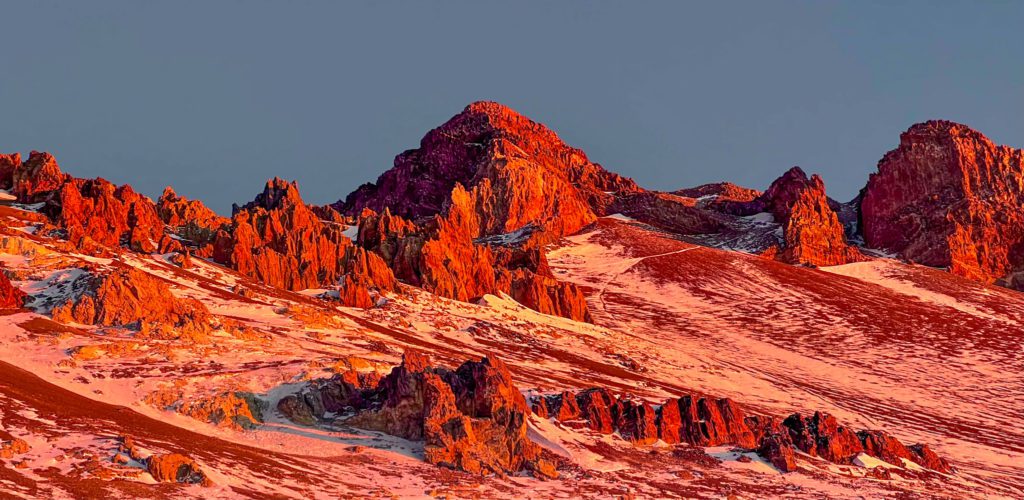
Day 7
Up with the sun to another nice day. More clouds than the days before. It had been a cold below zero and windy night, so I slept fully clothed, which was good enough; the constant peeing was the only annoyance. Today we headed to Camp 3, called Nido de Condores 5,380m (17,650ft). It took us about four hours, and everyone was doing great. We found as comfortable ground as possible to set our tents and then prepared for dinner with a beautiful sunset, followed by some much-needed sleep.
Day 8
We packed our porter’s bag with tents and food and then loaded our packs. Soon we were on the trail for the three-to-four-hour hike to high camp, Colera 5,870m (19,680ft). We arrived in good time with the team intact, everyone was feeling good. In no time, we set up our tents and prepared our needed gear for the cold night ahead. I was still acclimating. Far from 100% but overall, in good shape. I was having positive thoughts about the summit. Paul was also feeling good, but I sensed he was nervous about the summit push. We ate dinner, which was a warm something out of a large pot in the mess tent. I was not eating meat, my diet was mixing veggies with rice and legumes. I was feeling good about my calorie intake, along with lots of hot tea made by melting snow on our gas stove. The camp was busy with people going up and people coming down. Around 30 tents were set up. The tents were so close you could hear everyone’s conversations in the tent next door. Some people had satellite phones and were calling home. Paul and I hung out talking about family and future hikes. The weather looked good for an early start, a 10-hour hike to the summit and a six-to-eight-hour hike back to camp.

Day 9, Summit Day
We were up early. I can’t remember exactly what time, maybe around 3:30 a.m. It was very cold and dark, but fortunately, there was no wind. The stars were out, which is always a good sign. Close to the horizon was a setting moon, which meant warming morning light was coming. We headed out — four guides and nine hikers, everyone in good spirits. This was my tenth alpine-style summit attempt. If the weather is ok and you are reasonably comfortable in your choice of layers with warm hands and feet, then hiking can be quite enjoyable at night. You focus on your feet as the headlamp lights up each step. Sometimes there is conversation but mostly you are free to just keep your mind focused on the task at hand. This is where guide services are great investments. If you have a busy lifestyle and love to climb mountains for the first time, invest in a guide service. By doing so, you’re able to leave all the navigation and safety concerns and trail and weather decisions to the guides, allowing you to solely focus on the physical and mental work required to get to the top. About two hours into the hike the western sky started to brighten. An hour later that iconic shadow of the mountain peak reflected on the valley below.
At our first long break, I sensed there were two groups forming in our team. There were five in one group that were more acclimated and moving faster than Paul, Jack and me. The difference in the two team’s paces concerned me. How was this going to play out? Meanwhile, I drank some water and ate energy bars. I was beginning to wish I was alone with a guide, or at least a smaller group. A large group like this means the pace is set by the lead guide. If he feels everyone is keeping up with him, at a pace that gets the team to the top and back safely in a timely manner, then he will move at that pace. The morning light was warming, and the view was spectacular. This is big time, we were heading for the top. I was feeling good, the view and magnificence of the mountain were amazing. As the adventure was now getting real, I was reminded of the reason I love to climb.
